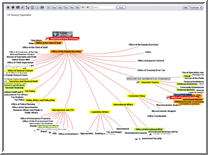-
Problem: What started as the Great Liquidity Crisis of 2008 has become the Great Economic Crisis of 2008. Now Act II of TARP in February 2009.
-
Goal: Generate new sources of public trust and confidence to unfreeze credit, stimulate collaborations, and encourage
innovation.
-
Solution: Make transparency a part of every transaction using public money, not just the contracts, but the organizations and people involved in giving and getting the funds. Transparency is the key to trust and confidence, foundations of a healthy economy, and the greatest possible dividend from the use of public money.
From trust to a healthy economy through transparency
Full transparency "connects the dots" between bits of information into a whole pattern
Transparency for Trust in Economic Rescue Spending
Focus on inital Troubled Assets Recovery Program (TARP)
As the financial crisis of September-October, 2008,morphed into the whole-system economic crisis of October-December, the need for transparency in the use of $2-going-on-$3 trillion in "emergency" spending (equity and loans) has intensified.
